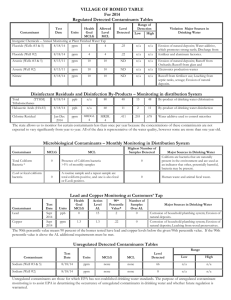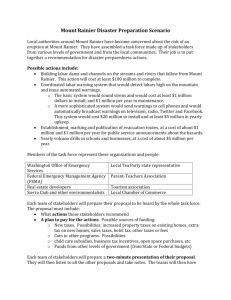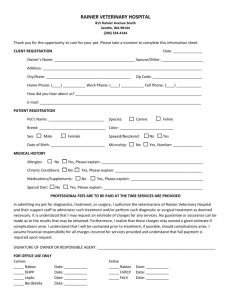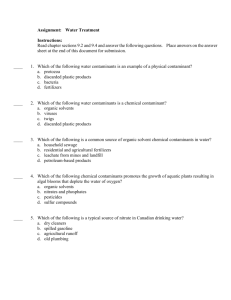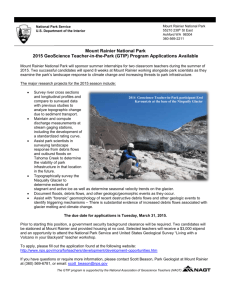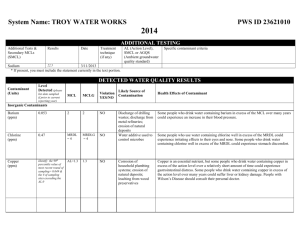Consumer Confidence Report
advertisement
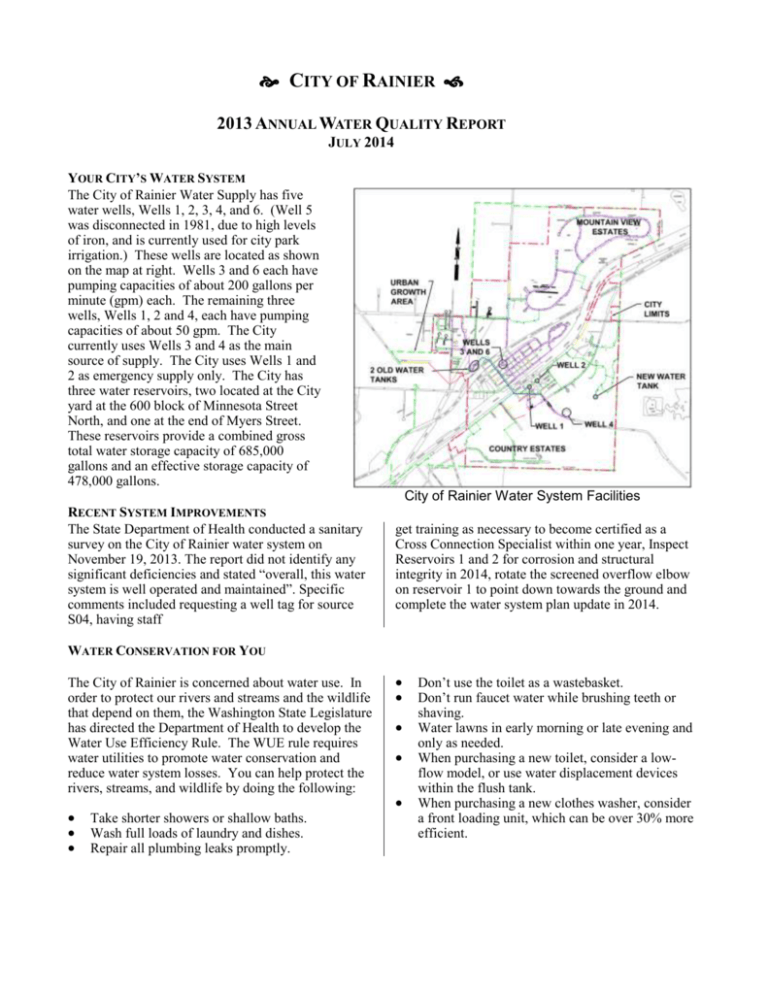
CITY OF RAINIER 2013 ANNUAL WATER QUALITY REPORT JULY 2014 YOUR CITY’S WATER SYSTEM The City of Rainier Water Supply has five water wells, Wells 1, 2, 3, 4, and 6. (Well 5 was disconnected in 1981, due to high levels of iron, and is currently used for city park irrigation.) These wells are located as shown on the map at right. Wells 3 and 6 each have pumping capacities of about 200 gallons per minute (gpm) each. The remaining three wells, Wells 1, 2 and 4, each have pumping capacities of about 50 gpm. The City currently uses Wells 3 and 4 as the main source of supply. The City uses Wells 1 and 2 as emergency supply only. The City has three water reservoirs, two located at the City yard at the 600 block of Minnesota Street North, and one at the end of Myers Street. These reservoirs provide a combined gross total water storage capacity of 685,000 gallons and an effective storage capacity of 478,000 gallons. City of Rainier Water System Facilities RECENT SYSTEM IMPROVEMENTS The State Department of Health conducted a sanitary survey on the City of Rainier water system on November 19, 2013. The report did not identify any significant deficiencies and stated “overall, this water system is well operated and maintained”. Specific comments included requesting a well tag for source S04, having staff get training as necessary to become certified as a Cross Connection Specialist within one year, Inspect Reservoirs 1 and 2 for corrosion and structural integrity in 2014, rotate the screened overflow elbow on reservoir 1 to point down towards the ground and complete the water system plan update in 2014. WATER CONSERVATION FOR YOU The City of Rainier is concerned about water use. In order to protect our rivers and streams and the wildlife that depend on them, the Washington State Legislature has directed the Department of Health to develop the Water Use Efficiency Rule. The WUE rule requires water utilities to promote water conservation and reduce water system losses. You can help protect the rivers, streams, and wildlife by doing the following: Take shorter showers or shallow baths. Wash full loads of laundry and dishes. Repair all plumbing leaks promptly. Don’t use the toilet as a wastebasket. Don’t run faucet water while brushing teeth or shaving. Water lawns in early morning or late evening and only as needed. When purchasing a new toilet, consider a lowflow model, or use water displacement devices within the flush tank. When purchasing a new clothes washer, consider a front loading unit, which can be over 30% more efficient. WATER QUALITY PROTECTION PROGRAMS The City is committed to supplying its customers with high quality and aesthetically pleasing drinking water. The City has adopted practices to ensure that the drinking water supplied to its customers meets or exceeds all federal and state standards. The following documents are available for the Public to access at City Hall. Water System Comprehensive Plan. A comprehensive analysis of all aspects of the water system identifying current and future plans by the City to continue to provide high quality drinking water to its customers has been completed and needs approved by Washington State Department of Health. The new plan includes revised Water Use Efficiency and Wellhead Protection Programs. The Water Use Efficiency program provides general guidance on how the City promotes water use efficiency. The Wellhead Protection Program identifies sensitive areas and potential contamination sources around the wells. Residents wishing to provide input on water issues or this report may contact City staff at City Hall or attend the regularly scheduled City Council meetings on the second and fourth Tuesday of each month at 7:00 p.m. at City Hall. WATER QUALITY MONITORING REQUIREMENTS Existing state and federal law requires water systems to monitor for numerous contaminants on a regular basis. The City is currently in compliance with Contaminant Type Bacteria Nitrate Inorganic (IOC), Synthetic Organic (SOC) & Volatile Organic (VOC) Chemicals and Radionuclides Lead and Copper Disinfectant Byproducts existing water quality monitoring requirements. The following table summarizes the City’s water quality monitoring requirements. Monitoring Requirement Three (3) samples per month in the distribution system, September through May, and two (2) samples per month June through August. One sample per year at each well. One (1) sample every three years at each active well unless testing is waived by the State Health Department. Wells Nos. 1 and 2 do not require testing because they are not active. SOC testing has been reduced for Wells Nos. 3, 4 and 6 due to low vulnerability. Lead and copper samples were last collected in June 2013. None. Only required for systems that add chlorine. WATER QUALITY MONITORING RESULTS During 2013, no coliform bacteria were detected in the water system. The City of Rainier is required by law to test for total and fecal coliform bacteria in the distribution system three times per month when school is in session, and two times per month in June, July and August. Additional tests are also required as follow-up to any positive tests. A coliform Maximum Contaminant Level violation is two positive samples in any given month. In 2013 Rainier took a total of 33 coliform samples. All coliform samples taken in 2013 were negative for coliform bacteria. (1) Nitrate levels. The following table shows nitrate levels in ppm (1) detected in City of Rainier wells. Year Well No. 3: Well No. 4: 2011 2.3 1.2 2012 1.6 > 1.0 2013 2.0 1.2 Well No. 6: MCL less than 0.2 less than 1.0 10 less than 1.0 The City of Rainier tests its groundwater for over 120 different inorganic, volatile and synthetic organic compounds every three years, unless a waiver is obtained from the Washington State Department of Health. No samples for these compounds were required in 2013. ppm: Parts per million. One ppm is equivalent to one second in 11½ days, or 1 inch in 15.8 miles. INORGANIC WATER QUALITY DATA The items in the table below were detected in the City of Rainier’s water during the most recent rounds of testing for inorganic chemicals. Additional Class of Contaminant Primary (2) Secondary (6) (1) (2) (3) (4) (5) (6) (7) Contaminant Sodium Turbidity Chloride Sulfate MCL (1) 20 ppm (3) 1 NTU (4) 250 ppm 250 ppm information on analyses of Rainier’s water supply can be obtained from the Public Works Department at (360) 446-2636. Highest Level Detected 7 ppm 0.3 NTU (5) 4.0 ppm (7) 5.0 ppm Possible Sources Naturally occurring minerals Naturally occurring minerals Naturally occurring minerals Naturally occurring minerals MCL is Maximum Contaminant Level: The highest level of a contaminant allowed in drinking water. Primary Contaminants: Substances regulated due to their direct or indirect health effects. Sodium does not have an actual MCL. There is, however, a level of concern at or above 20 ppm for individuals on sodium restricted diets. The sodium level in Well 6 was 33 ppm in May 2010, however Well 6 was not used in 2010 or 2011, and will be used in the future only in conjunction with other wells to maintain sodium below 20 ppm in the distribution system. The MCL for turbidity only applies to surface water supplies. Rainier uses groundwater, so this standard does not apply. NTU is Nephelometric (neh-fellow-metric) Turbidity Unit, the unit of measure for turbidity, or cloudiness of the water. Secondary Contaminants: Substances regulated due to their effect on taste, odor, or appearance. The highest level of chloride found in Wells 3 and 4 was 4.0 ppm. The chloride level in Well 6 was 179 ppm in 2010. However Well 6 was not used in 2010 or 2011, and will be used in the future only in conjunction with other wells, so that distribution system levels of chloride will be significantly lower than the level in Well 6. LEAD AND COPPER The City of Rainier has a corrosion control treatment facility to reduce the risk of lead and copper leaching from household plumbing. The compliance requirement is that 90% of all services sampled after at least 6 hours of non-use must be below the action levels for both lead and copper. Lead and copper monitoring results in 2013 showed compliance with 90th percentile lead and copper action levels. One out of ten samples taken exceeded the standard for lead, and no samples exceeded the standard for copper. Since 90% of the samples did not exceed the action levels, the system is not required to take any further action. To minimize the amount of lead or copper that could be in your drinking water it is recommended that, if water has not been used from that tap for six hours or more, you flush your water tap for approximately 1 minute before filling a drinking water glass, bottle or pitcher. Water flushed from taps can be used for watering plants or for washing, without any undue health risk. OTHER MONITORING RESULTS Other sampling that was completed in the past three years includes unregulated minerals and physical properties, and radionuclides. Unregulated minerals and physical properties detected in the past three years include hardness and electrical conductivity. The most recent hardness test results were 57 ppm in Well 3, 52 ppm in Well 4, and 224 ppm in Well 6, expressed as equivalents of calcium carbonate. Water with hardness below 55 ppm is considered soft water, 55 to 100 ppm is considered a slightly hard water, 100 to 200 ppm is considered a moderately hard water, and greater than 200 ppm is considered a very hard water. So Wells 3 and 4 are soft to slightly hard waters, and Well 6 is very hard water. But Well 6 will be used only in conjunction with other wells, so that distribution system levels of hardness will be significantly lower than 224 ppm, generally in the slightly to moderately hard range. The most recent electrical conductivity test results were 143 mhos/cm in Well 3 in 2007, 98 mhos/cm in Well 4 in 2010, and 520 mhos/cm in Well 6 in 2010. mhos/cm (micro mhos per centimeter) is a measure of conductivity, and is generally used as an estimate of the total amount of dissolved minerals in the water. Water with a conductivity of greater than 700 mhos/cm is considered to have excessive mineral content. Radionuclides is a test for any traces of radioactive material in the water. No radionuclides have ever been detected in any of Rainier’s wells. GENERAL HEALTH EFFECTS INFORMATION Groundwater travels through the ground, dissolving naturally occurring minerals that are present. It can also pick up substances resulting from the presence of animals or human activity. Contaminants that may be present include microorganisms, natural minerals, and any chemicals, oils, pesticides or herbicides dumped on or leaked into the ground. To ensure that tap water is safe to drink, EPA limits the amount of certain contaminants in water provided by public water systems through establishment of Maximum Contaminant Levels, or MCLs. Some people may be more vulnerable to contaminants in drinking water than the general population. Immune-compromised persons, such as persons undergoing chemotherapy, persons who have undergone organ transplants, persons with HIV/AIDS or other immune system disorders, some elderly, and infants can be particularly at risk from infections. These people should seek advice about drinking water from their health care provider. EPA and Centers for Disease Control guidelines on appropriate means to lessen the risk of infection by microbial contaminants are available from the Safe Drinking Water Hotline (800-426-4791). FAQ’S - FREQUENTLY ASKED QUESTIONS Where can I find out more information about my drinking water? City of Rainier 102 Rochester St. Rainier, WA 99327 (360) 446-2265 State Department of Health 243 Israel Road S.E. 1st floor, PO Box 47823 Olympia, WA 98504-7823 (360) 236-3030 www.doh.wa.gov/ehp/dw How can I get more involved in decisions affecting my drinking water? The Rainier City Council regularly meets at 7:00 p.m. at the Rainier City Hall on the second and fourth Tuesday of each month. Environmental Protection Agency Safe Drinking Water Act Hotline (800) 426-4791 www.epa.gov/safewater water impurities and potential health effects can be obtained by calling the Environmental Protection Agency’s Safe Drinking Water Hotline at 1-800-426-4791. Is fluoride or chlorine added to our drinking water? No, the City does not add fluoride or chlorine to its drinking water supply. Additional questions or comments about the City’s water supply, or other general drinking water issues can be directed to the following contacts: Who regulates bottled water? The Federal Food and Drug Administration regulates contaminants in bottled water and is responsible for providing the same levels of public health protection. Is bottled water cleaner and safer than tap water? Is anything added to the City of Rainier’s drinking water? Drinking water, including bottled water, may reasonably be expected to contain at least small amounts of some impurities. The presence of impurities does not necessarily indicate that water poses a health risk. More information about Yes. The City of Rainier adds a small amount of sodium hydroxide to the water to reduce its natural acidity and thereby reduce the amount of lead and copper in your water. Please see the preceding section on lead and copper. The City of Rainier is an Equal Opportunity Provider For more information visit our web page at http://www.ci.rainier.wa.us/
